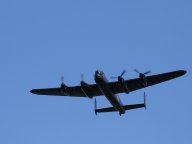 Developed from the Avro Manchester, the Avro Lancaster was the heavy bomber of World War Two.
Developed from the Avro Manchester, the Avro Lancaster was the heavy bomber of World War Two.
Few would question that the Lancaster was the most effective bomber on either side in World War II. -- Marshall of the Royal Air Force Sir Michael Beetham
There can be no better tributes to the Lancaster than those to be found in the county of Lincolnshire. Bearing in mind the importance of the county's airfields to the Lancaster, it is fitting that Lincolnshire is still home to two Lancasters, both of which are available for the public to see. -- Peter Jacobs
 Developed from the Avro Manchester, the Avro Lancaster was the heavy bomber of World War Two.
Developed from the Avro Manchester, the Avro Lancaster was the heavy bomber of World War Two.
The Avro Manchester was a new generation of twin-engined heavy bombers using two powerful Rolls-Royce Vulture engines. These engines proved too unreliable. More Avro Manchesters were lost through engine failure than enemy action! The Avro Manchester was withdrawn from service in 1942, after 200 aircraft had been built.
A new design took to the air in January 1941 using four less powerful but far more reliable Rolls-Royce Merlin engines. The first off the production line made its maiden flight on Halloween in the same year.
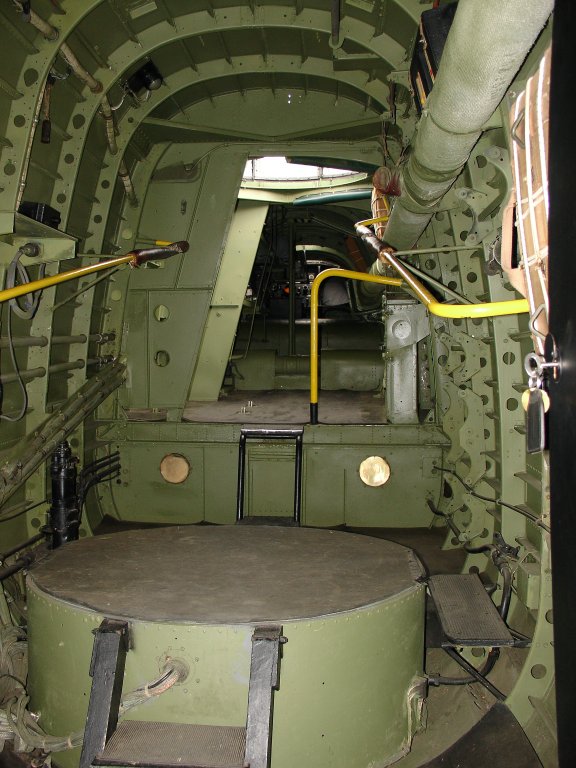 Primarily a night bomber, the Avro Lancaster was to be the main bomber of Bomber Command throughout WWII.
Primarily a night bomber, the Avro Lancaster was to be the main bomber of Bomber Command throughout WWII.
Up until the introduction of heavy bombers, the RAF had relied upon the Fairey Battle, Bristol Blenheim, Handley Page Hampden, Vickers Wellesley, Vickers Wellington (exception) and Armstrong Whitworth Whitley, but these proved too slow, too short range, too low a flight ceiling and incapable of carrying heavy payloads. The exception was the Vickers Wellington.
With its distinctive twin-tail fin and four Merlin engines, the Lancaster carried a crew of seven: pilot, navigator, flight engineer, bomb aimer (doubled as front gunner), wireless operator, mid-upper and rear gunners. Irrespective of rank, the pilot was the commanding officer.
The crews were invariably in their early twenties. A crew member as old as twenty-five would be regarded as ancient.
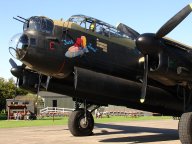 Before the start of WWII, an Operational Requirements Directive was issued for a heavy bomber.
Before the start of WWII, an Operational Requirements Directive was issued for a heavy bomber.
Short Brothers, Handley Page and Avro took up the challenge. The results were the Short Sterling, Handley Page Halifax and the Avro Manchester.
All three heavy bombers were failures, but Roy Chadwick chief engineer at Avro, convinced he had a good airframe, turned a poor design into the highly successful Avro Lancaster.
The Lancaster entered service in 1942, with 44 Squadron (based at RAF Waddington) and 97 Squadron (based at RAF Woodhall Spa, delivered whilst still at RAF Coningsby). The range and payload capability, meant the Lancaster was able to strike at the heart of the German military machine.
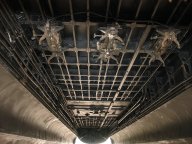 The first operational sortie by Lancasters was a mine laying operation on the night of 3/4 March 1942 by 44 Squadron. Four Lancasters took part, led by Squadron Leader John Nettleton.
The first operational sortie by Lancasters was a mine laying operation on the night of 3/4 March 1942 by 44 Squadron. Four Lancasters took part, led by Squadron Leader John Nettleton.
The first major sortie was an attack on Augsburg on 17 April 1942. A joint expedition by 44 and 97 Squadrons. The target was submarine diesel engine works in southern Germany. The daring raid was at low level in broad daylight. Of the 12 Lancasters that took part in the raid, only 5 returned. Squadron Leader John Nettleton who led the raid was awarded the Victoria Cross.
By the end of 1942, twelve squadrons of Bomber Command were equipped with Lancasters.
Lancasters were manufactured by Metropolitan-Vickers, Armstrong Whitworth, Austin Motor Company as well as Avro. The plane was also manufactured in Canada by Victory Aircraft using Packard-built Merlin engines.
Initially the Lancaster was used on daytime raids, but the level of losses was far to high, and Bomber Command switched to night flying. There was also a change of strategy. Initially, precision bombing of military targets, but with the change of strategy and Arthur 'Bomber' Harris taking charge of Bomber Command, the targets became cities and civilian populations. The raids were intended to terrorise the Germans into submission.
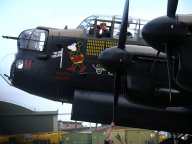 For a time nighttime raids suffered lower losses, but as the Germans learnt, losses once again mounted. A temporary reduction in the losses, with the use of chaff, which foiled the German ground radar, but with the air-to-air radar installed on the German interceptors, losses once again mounted.
For a time nighttime raids suffered lower losses, but as the Germans learnt, losses once again mounted. A temporary reduction in the losses, with the use of chaff, which foiled the German ground radar, but with the air-to-air radar installed on the German interceptors, losses once again mounted.
Successful German interceptors were downing six Lancasters in a night.
Lancasters were particularly vulnerable to an attack from below, as this was their blind spot.
For D-Day, Lancasters reverted back to daylight raids, as the nearness to the English coast meant they had fighter escorts.
Lancasters using the 11,000 lb Tallboy blockbuster bomb developed by Barnes Wallis, were able to attack hardened U-Boat pens at Le Havre.
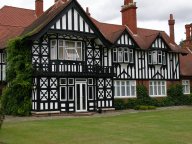 9 and 617 squadron successfully attacked the German battleship Tirpitz holed up in a Norwegian fjord using Tallboy. The Tirpitz was sunk by a direct hit from a Tallboy.
9 and 617 squadron successfully attacked the German battleship Tirpitz holed up in a Norwegian fjord using Tallboy. The Tirpitz was sunk by a direct hit from a Tallboy.
A yet bigger bomb, the 22,000 lb Grand Slam, again designed by Barnes Wallis, was used to attack a German viaduct. It was a deep penetration bomb, designed to penetrate concrete, burrow 30 ft into the ground, then create a local earthquake. Too large to fit in the Lancaster bomb bay, it was slung below the aircraft with an electrical release mechanism. Grand Slam was delivered to its target by 617 Squadron.
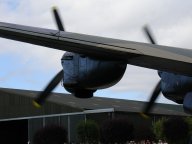 One of the most daring Lancaster raids, and the one that captured the public imagination, was the
617 Squadron Dambusters Raid, Operation Chastise, on the Ruhr Valley on the night of 16/17 May 1943. A mission led by Squadron Leader Guy Gibson using a revolutionary bouncing bomb designed by Barnes Wallis. A mission imortalised by the 1950s film The Dam Busters co-staring Richard Todd as Guy Gibson and Sir Michael Redgrave as Barnes Wallis.
One of the most daring Lancaster raids, and the one that captured the public imagination, was the
617 Squadron Dambusters Raid, Operation Chastise, on the Ruhr Valley on the night of 16/17 May 1943. A mission led by Squadron Leader Guy Gibson using a revolutionary bouncing bomb designed by Barnes Wallis. A mission imortalised by the 1950s film The Dam Busters co-staring Richard Todd as Guy Gibson and Sir Michael Redgrave as Barnes Wallis.
The first 1,000 bomber raid, Operation Millennium, was on Cologne. Approximately 1,500 tons of bombs were dropped on Cologne that night, causing more damage than all previous sorties on the city. Cologne was virtually destroyed, only 300 houses remained. Although this stretched the resources of the RAF to the limit, ramped up war production made more of these raids possible. The first raid caught the Germans by surprise. Later raids suffered much heavier losses.
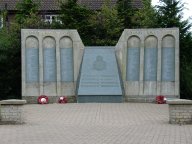 Controversial then, and even more controversial now, was the carpet bombing of German cities which led to very high civilian losses. The view at the time was that this was all out war.
Controversial then, and even more controversial now, was the carpet bombing of German cities which led to very high civilian losses. The view at the time was that this was all out war.
At first, and following a warning from President Roosevelt, both sides respected each others cities. A German bomber off course, dropped its payload on London. The gloves were then off, and both sides mounted raids on each others cities.
The worst of these raids was on Dresden, where the heavy bombing resulted in a firestorm which completely destroyed the city. 769 Lancasters, split into two waves took part in the raid. 1,478 tons of high explosives and 1,182 tons of incendiaries. An estimated tens of thousands of civilians were killed, including many thousands of refugees.
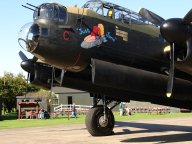 The Dresden raid was even more destructive than the earlier raid on Hamburg 6 months previous.
The Dresden raid was even more destructive than the earlier raid on Hamburg 6 months previous.
Germany surrendered 11 weeks later, following the raid on Dresden.
War criminals are always on the other side, the losing side. Had the Allies lost, it is highly probable that Arthur Harris would have been charged as a war criminal.
But it should be noted that an international review by the Red Cross of the Law of Air Warfare concluded that [International Review of the Red Cross no 323, p.347-363 The Law of Air Warfare (1998)]:
In examining these events [aerial area bombardment] in the light of international humanitarian law, it should be borne in mind that during the Second World War there was no agreement, treaty, convention or any other instrument governing the protection of the civilian population or civilian property, as the Conventions then in force dealt only with the protection of the wounded and the sick on the battlefield and in naval warfare, hospital ships, the laws and customs of war and the protection of prisoners of war.
In hindsight, although we may think it was a violation of the norms of warfare (for both sides to attack each others cities) there was no violation of International Law taking place.
Communist East Germany allowed the landmark Church of our Lady to remain in its derelict state as a monument to the bombing of Dresden. Following the fall of the Berlin Wall and the reuniting of East and West Germany, the church has been rebuilt as a symbol of hope of a better world. The church held its first service on Sunday 30 October 2005. [Dresden consecrates famed church and Frauenkirche - 'Dresden's miracle']
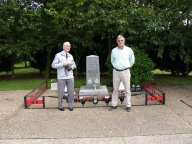 As the war in Europe drew to a close the last operational sorties of the Lancaster was
Operation Manna, to drop food not bombs.
As the war in Europe drew to a close the last operational sorties of the Lancaster was
Operation Manna, to drop food not bombs.
The Lancaster flew 156,308 operational sorties. Of the 7,377 Lancasters built, 3,249 were lost in action. Only 35 Lancasters completed more than 100 successful operations. The greatest survivor completed 139 operations and survived the war, only to be scrapped in 1947.
A secret report at the end of 1942 estimated that of every 100 aircrew only 13 would live to complete a tour of 50 operations.
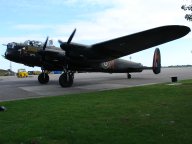 At East Kirkby, home to 57 Squadron and 630 Squadron, 848 aircrew lost their lives.
At East Kirkby, home to 57 Squadron and 630 Squadron, 848 aircrew lost their lives.
More than 50 million died in World War Two.
Of the 31 Victoria Crosses awarded to the British and Commonwealth Air Forces, 22 went to Bomber Command, 11 of these went to Lancaster crews.
A development of the Lancaster was the Avro Lincoln bomber. There was also a civilian airliner based on the Lancaster, the Lancastrian. Other aircraft that had their roots in the Lancaster were the Avro York and the Avro Shackleton.
The success of the Lancaster and its visionary designer Roy Chadwick can be seen in the fact that the Avro Shackleton saw service until May 1990. A design concept spanning 50 years.
Roy Chadwick was killed in a fatal air crash in August 1947 during the test flight of a prototype Avro Tudor II. The Avro Tudor was the forerunner of the Avro Lancastrian. Air accident investigators were to later discover that the ailerons had been wired the wrong way round.
The World moved on, the Lancaster was eventually replaced by the V Bombers, the best known of these being the Avro Vulcan.
The Vulcan last saw active service in the Falklands War.
The Vulcan in turn has been replaced by modern strike aircraft, the Jaguar and Tornado. The Tornado will eventually be phased out to be replaced by the Eurofighter.
There are 16 known Avro Lancasters remaining in the world, only two of which remain in air-worthy condition
One of the 16 surviving Lancasters is Just Jane NX611, now at Lincolnshire Aviation Heritage Centre, the former RAF East Kirkby.
Just Jane, built at the end of the war by Austin Motors to Far Eastern standards for service in the Pacific, last flew in 1970.
Tiger Force, of which Just Jane was part, was short lived following surrender by Japan. Just Jane was then sold to the French in 1952 for maritime service.
Ten years service with the French, Lancaster NX611 ended up doing 'sentry' duty outside RAF Scampton, the base where the Dambusters 617 Squadron was formed, and now home to the Red Arrows.
Towards the end of service with the French, NX611 was one of only three Lancasters still flying. On its long haul back to the UK from New Caledonia, it was the only Lancaster still flying.
RAF Scampton was not to be the final resting place for Just Jane. She now resides at East Kirkby, where to the delight of the many visitors, she is pulled out of her hanger, fires up all four Rolls-Royce Merlin engines and performs regular taxi runs.
Another surviving Lancaster, PA474 of the Battle of Britain Memorial Flight at RAF Coningsby, still flies, one of only two in the world that still flies.
PA474 was built in Chester in mid-1945 and like Just Jane was earmarked for Tiger Force in the Far East. However, the war with Japan ended before she could take part in any hostilities and she was assigned to Photographic Reconnaissance duties with 82 Squadron in East and South Africa.
On return to the UK and loaned out as use as a drone, then used as a trials aircraft for modelling laminar airflow over her modified wings. In 1964, PA474 was adopted by the Air Historical Branch (AHB) for future display at the proposed RAF Museum at Hendon.
PA474 joined the Battle of Britain Memorial Flight in 1973, and was adopted by the City of Lincoln in 1975.
PA474 was named City of Lincoln in recognition of the role Lincoln and in particular Lincolnshire played in WWII. In 2000, PA474 was renamed Micky the Moocher and given 61 Squadron markings in honour of Micky the Moocher.
61 Squadron were based at RAF Skellingthorpe, just outside Lincoln.
The original Mickey the Moocher EE176 was one of only 35 Lancasters to have flown and survived in excess of 100 missions. Mickey the Moocher is believed to have survived somewhere between 115 and 128 missions.
Mickey the Moocher survived the war, only to then be unceremoniously assigned to the scrap heap.
Worth watching:
The Dam Busters, 1954
Lancaster at War, DD Video, 2005 {features Lancaster PA474}
Lancaster Bombers, Delta Music, 2004 {features Lancaster Just Jane NX611}
Worth reading:
Peter Jacobs, The Lancaster Story, Silverdale Books, 2002
Patrick Bishop, Bomber Boys, Harper Press, 2007 [see BCID 5607211]
Terry Hancock, Bomber County, Midland, 2004 [see BCID 5758265]
Jonathan Falconer, Bomber Command Handbook, Sutton Publishing, 2003 [see BCID 5743096]
Ron Blake, Mike Hodgson, Bill Taylor, The Airfields of Lincolnshire, Midland Counties Publications, 1984 [see BCID 5758237]
During WWII many of the squadrons of Bomber Command were stationed in Lincolnshire, and up to the 1960s, many of the derelict airfields still remained. In total, 27 airfields in Lincolnshire were home to Lancasters either during or just after WWII. Lincolnshire is often referred to as Bomber County. A corner of
Lincoln Cathedral is dedicated to those who lost their lives.
Not far from Woodhall Spa the former RAF East Kirkby is now home to
Lincolnshire Aviation Heritage Centre. In addition to an operational Spitfire, the site houses Just Jane and many other interesting exhibits, including recovered remains of crashed aircraft.
Thorpe Camp, also not far from Woodhall Spa, has more exhibits.
Woodhall Spa, a former spa town, has a very impressive war memorial to the Dambusters. Also at Woodhall Spa, the
Petwood Hotel which was requisitioned during WWII as the Officers Mess for 617 Squadron. The Squadron Bar at Petwood has memorabilia from the period.
The Blue Bell Inn, an ancient roadside inn at Tattershall Thorpe, as well as serving excellent food and ales, has Dambuster connections, with signatures of members of the squadron on the ceiling.
RAF Coningsby, still an active RAF base, is home to the Battle of Britain Memorial Flight - a Lancaster escorted by a Hurricane and a Spitfire.
RAF Scampton, once home to the Dambusters, is now home to the Red Arrows.
RAF Waddington, the first base to take Lancasters, is still an operational base. It used to be the home to Vulcan V Bombers, and one still stands on display, it now houses AWACs, the Tornado and is due to take the Eurofighter.